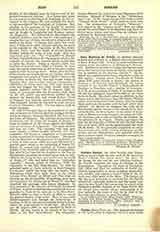

Juan Bautista de Toledo, an eminent Spanish sculptor and architect; b. at Madrid (date not known); d. there May 19, 1567. In 1547 he went to Rome and studied under the influence of Michelangelo Buonarroti. Afterwards he went to Naples, having been sent for by the Viceroy, Don Pietro de Toledo, who engaged him as architect to the emperor, Charles V. He designed and superintended many important works in that capital. Among others, the Strada di Toledo (since 1870 called Strada di Roma), the church of Santiago or S. Giacomo degli Spagnuoli; the square bastions to the Castello Nuovo; a large palazzo at Poselipo, or Pauselipo, and a number of fountains. In 1559, at the summons of Philip II, he went to Madrid and was appointed architect-in-chief of the royal works in Spain. His yearly salary as architect to the Crown was at first not more than 220 ducats, Philip’s policy, with his Spanish artists at least, being to assign them moderate allowances until he had tested their abilities. At Madrid he designed the Casa de la Misericordia and the facade of the church de las Descalzas Reales; works at Aceca; at the palace of Aranjuez; at Martininos de las Posadas, the palace of Cardinal Espinosa, and a villa at Esteban de Ambran for the secretary D. de Vargas. Toledo soon began his plan for the Escorial, of which he saw the first stone laid on April 23, 1563, and he superintended the work till his death. He was generally considered an architect of much merit, well-versed in philosophy, mathematics, and the belles-lettres, and endowed with all those qualities which Vitruvius considers necessary to form a good architect.
THOMAS H. POOLE

